Abstract
OBJECTIVE: To develop and test a clinical protocol for determining post-traumatic amnesia by retrospective questioning. To establish its limits and factors which influence reliability. DESIGN: Two independent assessments using the Rivermead post-traumatic amnesia protocol were undertaken by separate observers on various groups of patients at various time intervals. Analysis investigated the correlations between assessments, the percentage difference between assessments, the number of patients changing category, and the differences between these analyses in the different patient subgroups. Assessments were undertaken both in hospital and in the patients' homes. Four different patient groups were studied. These were group A: 12 inpatients with very severe head injury late after injury; Group B: 40 patients interviewed at home six months after injury; group C: 22 patients interviewed within a few weeks of injury at home; group D: 116 patients interviewed initially within a few weeks and then at six months, on both occasions at home. The Rivermead post-traumatic amnesia protocol involved clinical questioning of the patient to establish how long after injury (in hours/days/weeks) the patient regained continuous day to day memory. All periods of coma were included. Severity was categorised with standard criteria. RESULTS: Overall correlation was good (Spearman's r 0.79), but the correlation was lower for patients with post-traumatic amnesia < 24 hours and when there was a long delay between assessments. In all groups 19%-25% of patients changed categories between assessments, but only 2% changed by two categories. CONCLUSIONS: The assessment of post-traumatic amnesia with the Rivermead post-traumatic amnesia protocol is reasonably reliable. The misclassification rate however, is significant enough that some caution should be taken in individual cases. Other evidence does show post-traumatic amnesia to be valid, and it probably remains the best simple prognostic item available. In clinical practice one should avoid placing too much weight on post-traumatic amnesia alone.
Full text
PDF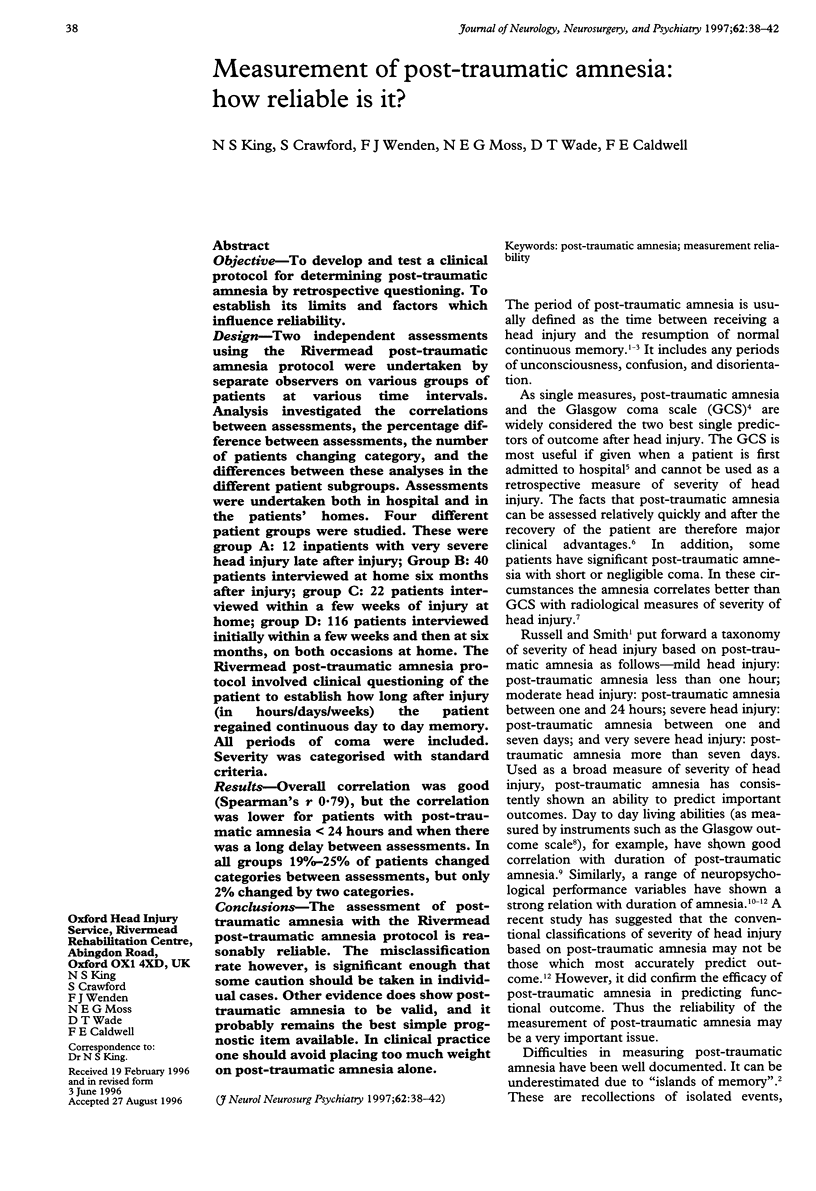
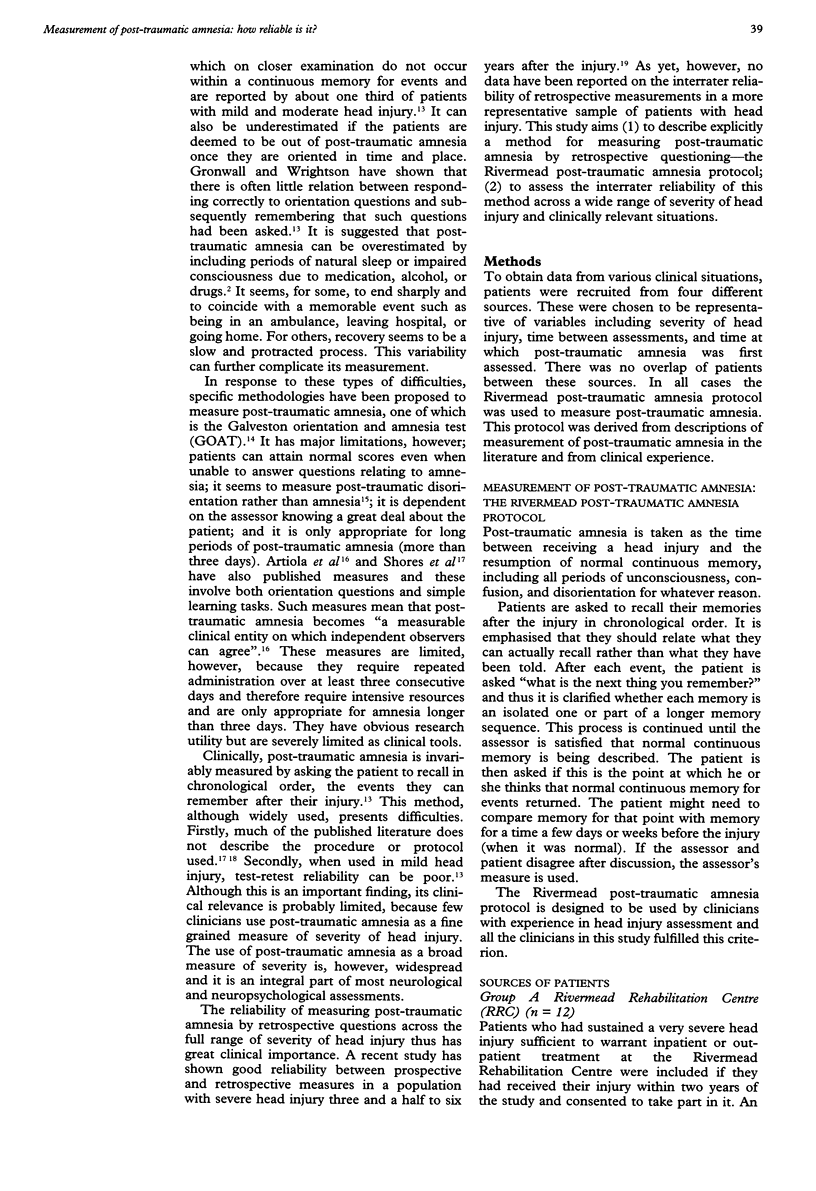
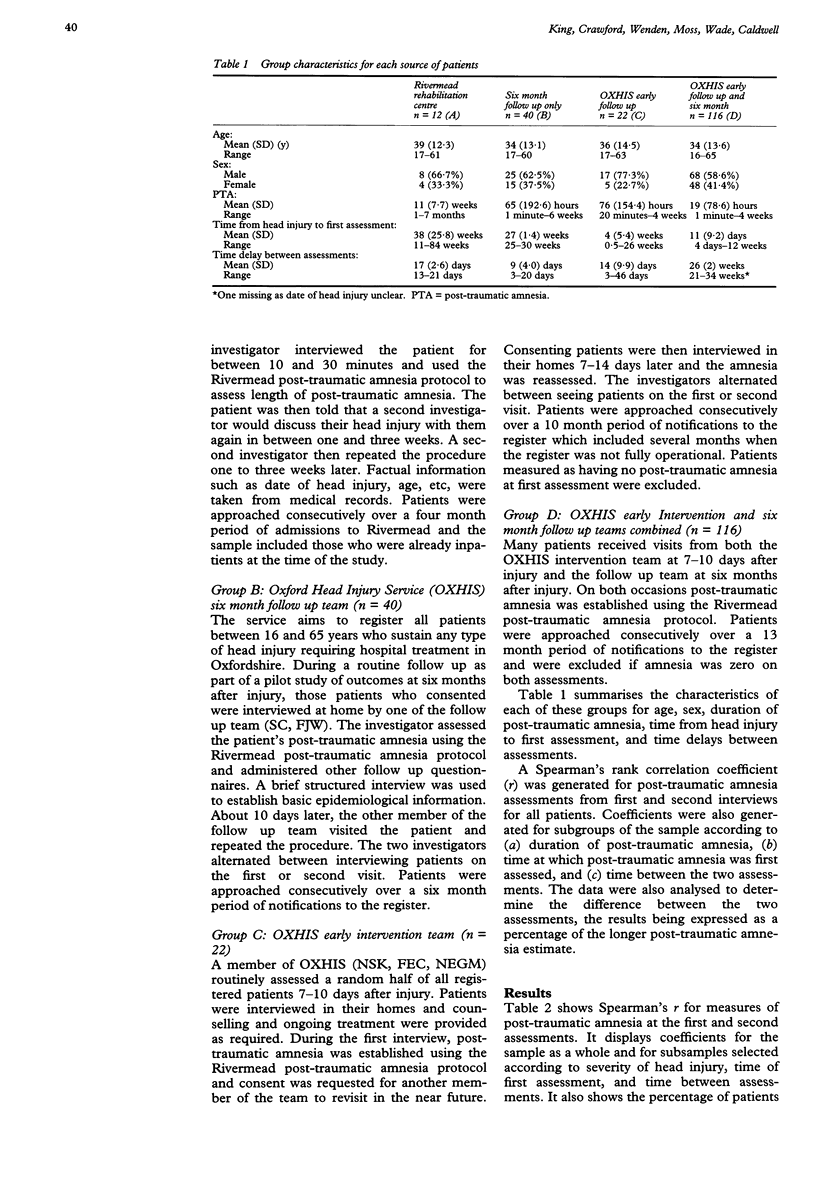
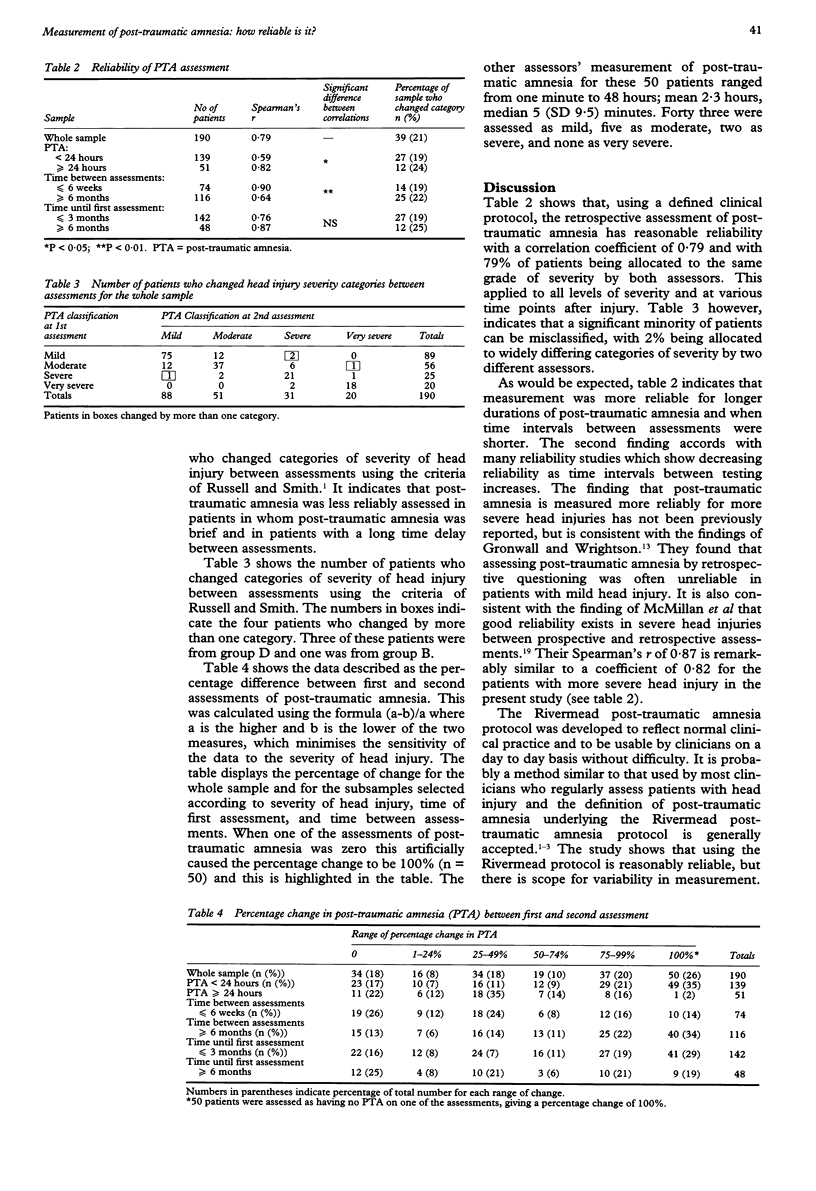
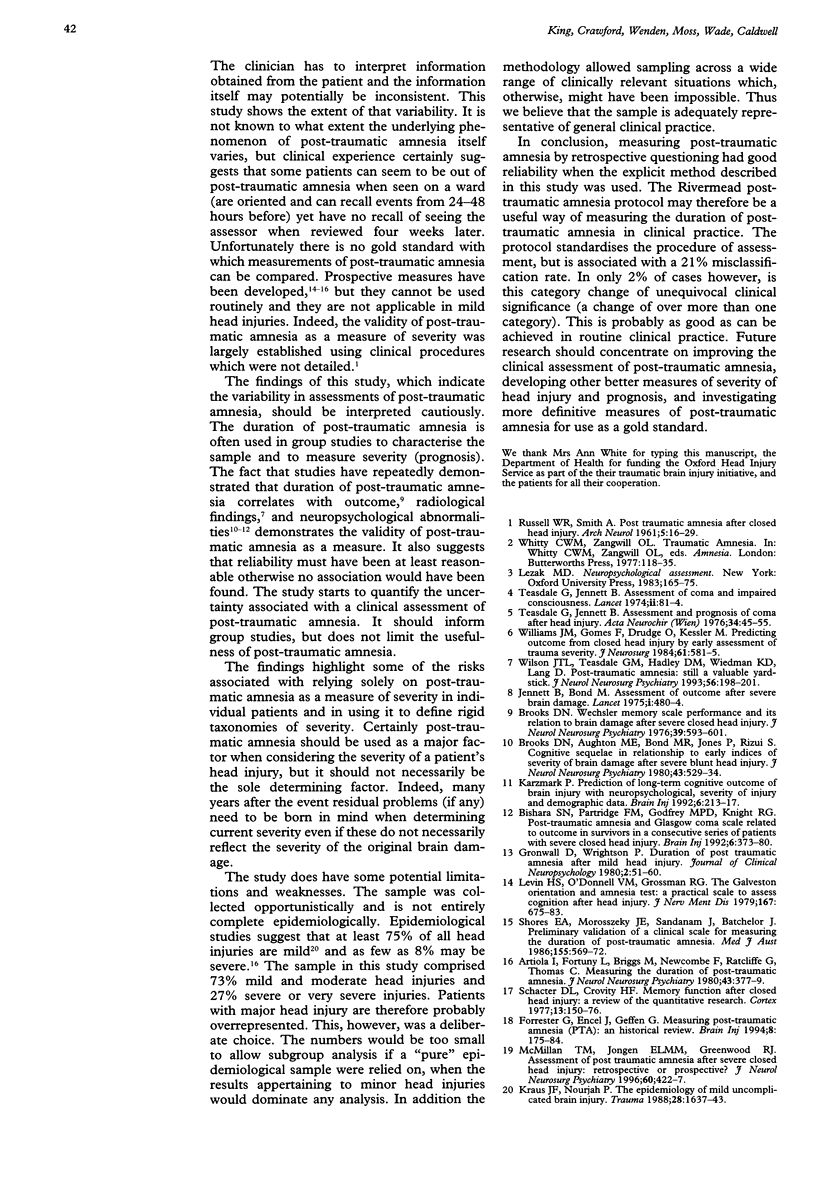
Selected References
These references are in PubMed. This may not be the complete list of references from this article.
- Bishara S. N., Partridge F. M., Godfrey H. P., Knight R. G. Post-traumatic amnesia and Glasgow Coma Scale related to outcome in survivors in a consecutive series of patients with severe closed-head injury. Brain Inj. 1992 Jul-Aug;6(4):373–380. doi: 10.3109/02699059209034952. [DOI] [PubMed] [Google Scholar]
- Brooks D. N., Aughton M. E., Bond M. R., Jones P., Rizvi S. Cognitive sequelae in relationship to early indices of severity of brain damage after severe blunt head injury. J Neurol Neurosurg Psychiatry. 1980 Jun;43(6):529–534. doi: 10.1136/jnnp.43.6.529. [DOI] [PMC free article] [PubMed] [Google Scholar]
- Brooks D. N. Wechsler Memory Scale performance and its relationship to brain damage after severe closed head injury. J Neurol Neurosurg Psychiatry. 1976 Jun;39(6):593–601. doi: 10.1136/jnnp.39.6.593. [DOI] [PMC free article] [PubMed] [Google Scholar]
- Forrester G., Encel J., Geffen G. Measuring post-traumatic amnesia (PTA): an historical review. Brain Inj. 1994 Feb-Mar;8(2):175–184. doi: 10.3109/02699059409150969. [DOI] [PubMed] [Google Scholar]
- Fortuny L. A., Briggs M., Newcombe F., Ratcliff G., Thomas C. Measuring the duration of post traumatic amnesia. J Neurol Neurosurg Psychiatry. 1980 May;43(5):377–379. doi: 10.1136/jnnp.43.5.377. [DOI] [PMC free article] [PubMed] [Google Scholar]
- Jennett B., Bond M. Assessment of outcome after severe brain damage. Lancet. 1975 Mar 1;1(7905):480–484. doi: 10.1016/s0140-6736(75)92830-5. [DOI] [PubMed] [Google Scholar]
- Karzmark P. Prediction of long-term cognitive outcome of brain injury with neuropsychological, severity of injury, and demographic data. Brain Inj. 1992 May-Jun;6(3):213–217. doi: 10.3109/02699059209029662. [DOI] [PubMed] [Google Scholar]
- Kraus J. F., Nourjah P. The epidemiology of mild, uncomplicated brain injury. J Trauma. 1988 Dec;28(12):1637–1643. doi: 10.1097/00005373-198812000-00004. [DOI] [PubMed] [Google Scholar]
- Levin H. S., O'Donnell V. M., Grossman R. G. The Galveston Orientation and Amnesia Test. A practical scale to assess cognition after head injury. J Nerv Ment Dis. 1979 Nov;167(11):675–684. doi: 10.1097/00005053-197911000-00004. [DOI] [PubMed] [Google Scholar]
- McMillan T. M., Jongen E. L., Greenwood R. J. Assessment of post-traumatic amnesia after severe closed head injury: retrospective or prospective? J Neurol Neurosurg Psychiatry. 1996 Apr;60(4):422–427. doi: 10.1136/jnnp.60.4.422. [DOI] [PMC free article] [PubMed] [Google Scholar]
- Schacter D. L., Crovitz H. F. Memory function after closed head injury: a review of the quantitative research. Cortex. 1977 Jun;13(2):150–176. doi: 10.1016/s0010-9452(77)80006-3. [DOI] [PubMed] [Google Scholar]
- Shores E. A., Marosszeky J. E., Sandanam J., Batchelor J. Preliminary validation of a clinical scale for measuring the duration of post-traumatic amnesia. Med J Aust. 1986 May 26;144(11):569–572. doi: 10.5694/j.1326-5377.1986.tb112311.x. [DOI] [PubMed] [Google Scholar]
- Teasdale G., Jennett B. Assessment and prognosis of coma after head injury. Acta Neurochir (Wien) 1976;34(1-4):45–55. doi: 10.1007/BF01405862. [DOI] [PubMed] [Google Scholar]
- Teasdale G., Jennett B. Assessment of coma and impaired consciousness. A practical scale. Lancet. 1974 Jul 13;2(7872):81–84. doi: 10.1016/s0140-6736(74)91639-0. [DOI] [PubMed] [Google Scholar]
- Williams J. M., Gomes F., Drudge O. W., Kessler M. Predicting outcome from closed head injury by early assessment of trauma severity. J Neurosurg. 1984 Sep;61(3):581–585. doi: 10.3171/jns.1984.61.3.0581. [DOI] [PubMed] [Google Scholar]


